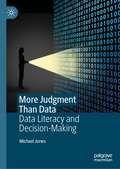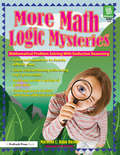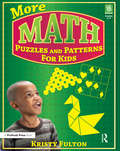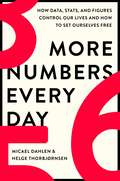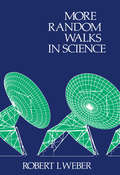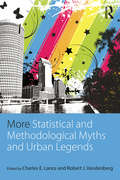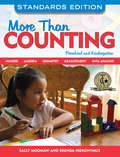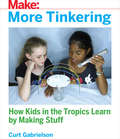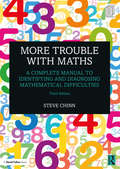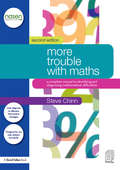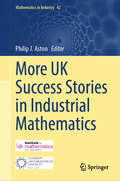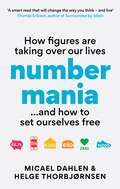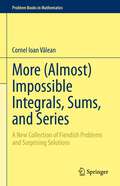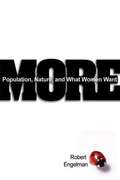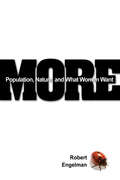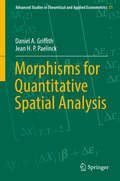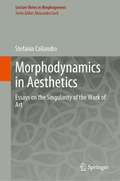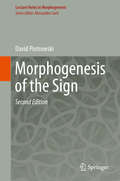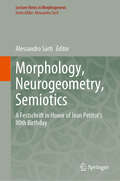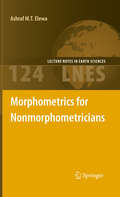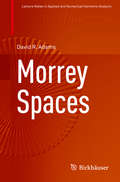- Table View
- List View
More Judgment Than Data: Data Literacy and Decision-Making
by Michael JonesMore data has been produced in the 21st century than all of human history combined. Yet, are we making better decisions today than in the past? How many poor decisions result from the absence of data? The existence of an overwhelming amount of data has affected how we make decisions, but it has not necessarily improved how we make decisions. To make better decisions, people need good judgment based on data literacy—the ability to extract meaning from data. Including data in the decision-making process can bring considerable clarity in answering our questions. Nevertheless, human beings can become distracted, overwhelmed, and even confused in the presence of too much data. The book presents cautionary tales of what can happen when too much attention is spent on acquiring more data instead of understanding how to best use the data we already have. Data is not produced in a vacuum, and individuals who possess data literacy will understand the environment and incentives in the data-generating process. Readers of this book will learn what questions to ask, what data to pay attention to, and what pitfalls to avoid in order to make better decisions. They will also be less vulnerable to those who manipulate data for misleading purposes.
More Math Games & Activities from Around the World
by Claudia ZaslavskyMath, history, art, and world cultures come together in this delightful book for kids, even for those who find traditional math lessons boring. More than 70 games, puzzles, and projects encourage kids to hone their math skills as they calculate, measure, and solve problems. The games span the globe, and many have been played for thousands of years, such as three-in-a-row games like Achi from Ghana or the forbidden game of Jirig from Mongolia. Also included are imaginative board games like Lambs and Tigers from India and the Little Goat Game from Sudan, or bead and string puzzles from China, and M+bius strip puzzles from Germany. Through compelling math play, children will gain confidence and have fun as they learn about the different ways people around the world measure, count, and use patterns and symmetry in their everyday lives.
More Math Logic Mysteries: Grades 5-8
by Marilynn L. Rapp BuxtonStudents love trying to solve challenging puzzles. So, why not build and review their math skills while they're having fun? More Math Logic Mysteries, the sequel to the best-selling Math Logic Mysteries, requires students to complete math problems and use deductive reasoning to unlock the clues needed to solve matrix-based logic problems.Mathematical skills covered include measurement, number operations, geometry, probability, fractions, decimals, percentages, and algebra. The puzzles range from simple introductions to matrix-based problems, to more difficult puzzles that cover advanced math topics. Each reproducible puzzle is based on an enjoyable story your students will love as they attempt to solve problems and crack the mysteries.This book includes a detailed how-to section for teaching logic puzzles and an in-depth answer key, so students can understand the thinking process behind each solution. After doing these fun and challenging puzzles, your students will ask for even More Math Logic Mysteries!Grades 5-8
More Math Puzzles and Patterns for Kids: Grades 2-4
by Kristy FultonMove beyond the norm in your math classroom and challenge students to think critically with More Math Puzzles and Patterns for Kids, a new companion book to the popular Math Puzzles and Patterns for Kids. This book contains more of students' favorite puzzles and patterns, as well as a few new ones for students to explore. All of the mathematical activities in this book were chosen for their important role in mathematics' history. Like its predecessor, this book explores the hottest concepts in puzzle solving—math logic puzzles—while teaching students how to use reasoning to solve some of math's biggest conundrums: real-life patterns and puzzles such as Fibonacci's sequence, Sudoku puzzles, tangrams, Pascal's triangle, and magic squares. Students will sharpen their math skills while they learn the basic premises behind each challenging puzzle and then use the skills they have learned to solve multiple versions of each puzzle. Grades 2-4
More Numbers Every Day: How Data, Stats, and Figures Control Our Lives and How to Set Ourselves Free
by Micael Dahlen Helge ThorbjørnsenYour personal number detox: learn how numbers have taken control of your life—and how to get it back. How many hours of sleep did you get last week? How many steps did you walk today? How many friends do you have? It seems everywhere you go, you&’re surrounded by numbers. You depend on them, so you think they&’re dependable, neutral, exact. But the truth? Numbers lie. They mislead. They&’re tricky, little manipulative devils. And they&’re in the process of really messing things up for you. You just don&’t know it yet. Today we all strive to quantify everything: calories, likes, website traffic, and even friends. We measure ourselves against others and compare our real experiences to imagined averages. But in our rush to measure, we can lose sight of what matters. From internationally renowned economics professors Micael Dahlen and Helge Thorbjørnsen, More Numbers Every Day is a timely and powerful investigation—and warning—about the trouble numbers can bring us. With groundbreaking, empowering, sometimes frightening, and sometimes funny research, they describe how numbers creep into our heads and bodies, affecting how we think and feel. But numbers aren&’t all bad. Sometimes they make us weaker, but sometimes they also make us stronger. More Numbers Every Day is more than just an exploration in to the somewhat mysterious, seemingly infinite pandemic of numbers. It&’s a numerical vaccination—for a happier and more integrally healthy life.
More Or Less
by Stuart J. MurphyIs your age more than 5? Is it less than 10? Eddie's got to guess. And he doesn't want to be wrong! Eddie has a booth at the school fair, guessing people's ages. He hasn't guessed wrong yet, but if he does, he gets dunked. Can Eddie keep guessing right -- and keep from getting wet? Comparing whole numbers and understanding what's more and what's less are a big part of Eddie's strategy, and an important math skill for young readers to learn.
More Random Walks in Science
by R.L. WeberMore Random Walks in Science is an anthology of fascinating and frequently amusing anecdotes, quotations, illustrations, articles, and reviews that reflect the more lighthearted aspects of the scientific world and the less serious excursions of the scientific mind. The book is guaranteed to delight anyone who has a professional or amateur interest in science.
More Statistical and Methodological Myths and Urban Legends: Doctrine, Verity and Fable in Organizational and Social Sciences
by Charles E. Lance Robert J. VandenbergThis book provides an up-to-date review of commonly undertaken methodological and statistical practices that are based partially in sound scientific rationale and partially in unfounded lore. Some examples of these “methodological urban legends” are characterized by manuscript critiques such as: (a) “your self-report measures suffer from common method bias”; (b) “your item-to-subject ratios are too low”; (c) “you can’t generalize these findings to the real world”; or (d) “your effect sizes are too low.” What do these critiques mean, and what is their historical basis? More Statistical and Methodological Myths and Urban Legends catalogs several of these quirky practices and outlines proper research techniques. Topics covered include sample size requirements, missing data bias in correlation matrices, negative wording in survey research, and much more.
More Than Counting
by Sally Moomaw Brenda HieronymusMake learning count with math activities and games for preschool and pre-kindergarten children that reflect early learning standards from the National Council of Teachers of Mathematics (NCTM). Combining new activities and favorites from the best-selling More Than Counting and Much More Than Counting by the same author team, this edition provides a total of 135 math lessons. Activities are organized by learning standard, which include number sense and operations, algebra, geometry, measurement and data analysis, and probability. Each activity includes a materials list, modifications for special needs, early learning standards connection, and common questions and answers.
More Than One
by Miriam SchleinA creative and colorful counting book for young readers demonstrates that one can actually be more than one, such as one pair of shoes is made up of two shoes and one week that is actually seven days.
More Tinkering: How Kids in the Tropics Learn by Making Stuff
by Curt GabrielsonTinkering is a way of learning through hands-on activity -- experimenting with materials and devices to see how they work, taking things apart, making small changes and improvements, exploring and inventing. Tinkering may seem like a form of play -- and it is -- but it is also a powerful way of discovering truths about science, engineering, and math. With this book, Curt Gabrielson follows up on his best-seller Tinkering: Kids Learn by Making Stuff with this all-new volume that features more than three dozen fun and educational tinkering projects based on his years of working with kids in the tropical island nation of Timor-Leste. Step-by-step instructions accompanied by full-color photos take you through a range of enjoyable projects that explore life sciences, physics, chemistry, earth sciences, and mathematics. You'll discover how math is used to make baskets, how fungi create fermentation, how electricity can make a magnet, how the greenhouse effect creates warming, and much more. The author also enlivens his latest batch of tinkering projects with colorful tales of his experiences in the tropic and the lives of the people he' s met there.Inside you'll find:Clear directions for making simple projects and doing activities that teach science, mathematics and engineeringProjects rooted in day to day life and experience in a small, developing nation in the Asian tropicsFull-color photographs throughoutExplicit connections to standard STEAM concepts, K-12Activities doable with less than $5 worth of common materialsThis book is perfect for parents, teachers, and students with an interest in hands-on, tinkering-based science and mathematics education, whether in traditional schools or in home-schooling situations. It will also be of interest to anyone who wants to learn more about developing nations, the culture and unique history of Timor-Leste, tropical nations or Asian cultures, with specific links to Indonesia, Portugal, or Australia.
More Trouble with Maths: A Complete Manual to Identifying and Diagnosing Mathematical Difficulties (David Fulton / Nasen Ser.)
by Steve ChinnNow in an updated third edition, this invaluable resource takes a practical and accessible approach to identifying and diagnosing many of the factors that contribute to mathematical learning difficulties and dyscalculia. Using a combination of formative and summative approaches, it provides a range of norm-referenced, standardised tests and diagnostic activities, each designed to reveal common error patterns and misconceptions in order to form a basis for intervention. Revised to reflect developments in the understanding of learning difficulties in mathematics, the book gives a diagnostic overview of a range of challenges to mathematical learning, including difficulties in grasping and retaining facts, problems with mathematics vocabulary and maths anxiety. Key features of this book include: Photocopiable tests and activities designed to be presented in a low-stress way Guidance on the interpretation of data, allowing diagnosis and assessment to become integrated into everyday teaching Sample reports, showing the diagnostic tests in practice Drawing on tried and tested methods, as well as the author’s extensive experience and expertise, this book is written in an engaging and user-friendly style. It is a vital resource for anyone who wants to accurately identify the depth and nature of mathematical learning difficulties and dyscalculia.
More Trouble with Maths: A Complete Manual to Identifying and Diagnosing Mathematical Difficulties (nasen spotlight)
by Steve ChinnMore Trouble with Maths acknowledges that there are many reasons why children and adults are unable to function mathematically. Difficulties include problems with rote learning basic facts and procedures, debilitating anxiety, poor working and short-term memories and mathematics vocabulary. Central to this new edition is a range of standardised tests and diagnostic activities, including a 15 minute test of basic mathematics, a thinking style test, tests of basic fact retrieval and maths anxiety. Guiding the reader in the interpretation of tests, this new edition shows how identifying the barriers to learning is the first step in a programme of intervention. Written in an engaging and user-friendly style, Steve Chinn draws on his extensive experience and expertise to: show how to consider and appraise the many factors relating to mathematical learning difficulties explain how these factors can be investigated explore their impact on learning mathematics. Emphasising the need for a clinical approach when assessing individuals, this book shows how diagnosis and assessment can become integrated into everyday teaching. This highly practical and relevant resource is a crucial resource for anyone who wants to accurately and effectively identify the depth and nature of mathematical learning difficulties and dyscalculia.
More UK Success Stories in Industrial Mathematics (Mathematics in Industry #42)
by Philip J. AstonThis volume highlights successful projects in which academic mathematicians in the United Kingdom got involved with solving problems in industry for which mathematics was essential. It contains a wide range of articles in areas ranging from music composition to climate change which describe successful collaborations between mathematicians / statisticians and industry. The impact that the work had on the companies involved and on people’s everyday lives is included in each article. The book conveys to the non-expert some of the many ways that mathematics and statistics have contributed to economic growth and societal well-being.
More Without Words: Mathematical Puzzles to Confound and Delight
by James TantonAll real life mathematics is problem solving. And all those fascinated by puzzles are problem solvers at heart. But thinking mathematically is a skill we have to learn and one which it is easy to forget. Recreational mathematicians and students can practise problem solving in different ways. In this book solving puzzles is practised in a different way from most books they will have seen before:• Readers get no clues to what the puzzle is about• They may take hours or even days to work out what is being asked of them• Even after that, some problems may have no solutionThe result of this challenge is a really challenging book that will fascinate anyone interested in puzzles and recreational mathematicians in particular. This volume contains 36 puzzles ranging from quite easy to more difficult. The sister volume Without Words: Mathematical Puzzles to Confound and Delight is also available – containing 36 more puzzles with more easy and fewer testing ones.
More. Numbers. Every. Day.: How Figures Are Taking Over Our Lives – And Why It's Time to Set Ourselves Free
by Micael Dahlen Helge ThorbjørnsenHow many steps have you done today?How many emails answered?How much money have you spent this week And how many hours have you slept?Welcome to the numberdemic, where a deluge of figures, stats and data manipulate your every move. From the way you work, date and exercise to the products you buy and the news you read, numbers have worked their way into every part of our lives. But is life better this way? How are all of those numbers affecting us?With fascinating, sometimes frightening and sometimes shrewdly funny research, behavioural economists Micael Dahlen and Helge Thorbjørnsen explain why we're so attached to numbers and how we can free ourselves from their tyranny. Along the way, you'll learn why viral videos, however inaccurate, become more convincing with every view; how numbers can affect the way we physically age, if we let them; why the more films you rate the less impressive you'll find them and how numbers that 'anchor' themselves in your brain can affect the size of your mortgage - plus much more.Sharp, insightful and totally engaging, MORE. NUMBERS. EVERY. DAY. is your vaccination against a world obsessed with numbers.'An entertaining and thought-provoking antidote to the tyranny of numbers in the modern world. By looking at the psychology of how we are tricked, goaded and often crushed by endless quantification, the authors present a winning case for weaning ourselves off number-dependence.'-Alex Bellos, author of Can You Solve My Problems?'Everybody should read this book. A smart and insightful read that will totally change the way you think - and live.'-Thomas Erikson, author of Sunday Times bestseller Surrounded By Idiots'Written in lucid, skillfully translated prose that puts the science into philosophical perspective, this shines a fascinating light on the modern-day obsession with numerical quantity over quality.' -Publishers Weekly'In 31,234 words Dahlen and Thorbjørnsen cast their four critical, and at times whimsical, eyes at our numbered existences revealing that consuming too much 'pi' might be bad for our health.'-Professor Scott Page, author of The Model Thinker
More: A New Collection of Fiendish Problems and Surprising Solutions (Problem Books in Mathematics)
by Cornel Ioan VăleanThis book, the much-anticipated sequel to (Almost) Impossible, Integrals, Sums, and Series, presents a whole new collection of challenging problems and solutions that are not commonly found in classical textbooks. As in the author’s previous book, these fascinating mathematical problems are shown in new and engaging ways, and illustrate the connections between integrals, sums, and series, many of which involve zeta functions, harmonic series, polylogarithms, and various other special functions and constants. Throughout the book, the reader will find both classical and new problems, with numerous original problems and solutions coming from the personal research of the author. Classical problems are shown in a fresh light, with new, surprising or unconventional ways of obtaining the desired results devised by the author. This book is accessible to readers with a good knowledge of calculus, from undergraduate students to researchers. It will appeal to all mathematical puzzlers who love a good integral or series and aren’t afraid of a challenge.
More: Population, Nature and What Women Want
by Robert EngelmanIn the capital of Ghana, a teenager nicknamed "Condom Sister" trolls the streets to educate other young people about contraception. Her work and her own aspirations point to a remarkable shift not only in the West African nation, where just a few decades ago women had nearly seven children on average, but around the globe. While world population continues to grow, family size keeps dropping in countries as diverse as Switzerland and South Africa. The phenomenon has some lamenting the imminent extinction of humanity, while others warn that our numbers will soon outgrow the planet's resources. Robert Engelman offers a decidedly different vision--one that celebrates womens' widespread desire for smaller families. Mothers aren't seeking more children, he argues, but more for their children. If they're able to realize their intentions, we just might suffer less climate change, hunger, and disease, not to mention sky-high housing costs and infuriating traffic jams. In More, Engelman shows that this three-way dance between population, womens' autonomy, and the natural world is as old as humanity itself. He traces pivotal developments in our history that set population--and society--on its current trajectory, from hominids' first steps on two feet to the persecution of 'witches' in Europe to the creation of modern contraception. Both personal and sweeping, More explores how population growth has shaped modern civilization --and humanity as we know it. The result is a mind-stretching exploration of parenthood, sex, and culture through the ages. Yet for all its fascinating historical detail, More is primarily about the choices we face today. Whether society supports women to have children when and only when they choose to will not only shape their lives, but the world all our children will inherit.
More: Population, Nature, and What Women Want
by Robert EngelmanIn the capital of Ghana, a teenager nicknamed "Condom Sister" trolls the streets to educate other young people about contraception. Her work and her own aspirations point to a remarkable shift not only in the West African nation, where just a few decades ago women had nearly seven children on average, but around the globe. While world population continues to grow, family size keeps dropping in countries as diverse as Switzerland and South Africa. The phenomenon has some lamenting the imminent extinction of humanity, while others warn that our numbers will soon outgrow the planet's resources. Robert Engelman offers a decidedly different vision--one that celebrates women's widespread desire for smaller families. Mothers aren't seeking more children, he argues, but more for their children. If they're able to realize their intentions, we just might suffer less climate change, hunger, and disease, not to mention sky-high housing costs and infuriating traffic jams. In More, Engelman shows that this three-way dance between population, women's autonomy, and the natural world is as old as humanity itself. He traces pivotal developments in our history that set population--and society--on its current trajectory, from hominids' first steps on two feet to the persecution of "witches" in Europe to the creation of modern contraception. Both personal and sweeping, More explores how population growth has shaped modern civilization--and humanity as we know it. The result is a mind-stretching exploration of parenthood, sex, and culture through the ages. Yet for all its fascinating historical detail, More is primarily about the choices we face today. Whether society supports women to have children when and only when they choose to will not only shape their lives, but the world all our children will inherit.
Morphisms for Quantitative Spatial Analysis (Advanced Studies In Theoretical And Applied Econometrics Ser. #51)
by Daniel A. Griffith Jean H. PaelinckThis book treats the notion of morphisms in spatial analysis, paralleling these concepts in spatial statistics (Part I) and spatial econometrics (Part II). The principal concept is morphism (e.g., isomorphisms, homomorphisms, and allomorphisms), which is defined as a structure preserving the functional linkage between mathematical properties or operations in spatial statistics and spatial econometrics, among other disciplines. The purpose of this book is to present selected conceptions in both domains that are structurally the same, even though their labelling and the notation for their elements may differ. As the approaches presented here are applied to empirical materials in geography and economics, the book will also be of interest to scholars of regional science, quantitative geography and the geospatial sciences. It is a follow-up to the book “Non-standard Spatial Statistics and Spatial Econometrics” by the same authors, which was published by Springer in 2011.
Morphodynamics in Aesthetics: Essays on the Singularity of the Work of Art (Lecture Notes in Morphogenesis)
by Stefania CaliandroThis book deals with the complexity of art by focusing on the singularity of the work of art. Gathering a selection of writings in art theory and semiotics, it explores the question of apprehending art from its perceptual aspects to aesthetic comprehension and understanding. Theoretical enquiries focus in particular on the dynamics of the perception of forms, the semiotic value of colour, the aesthetic phenomenon of empathy, the function of vision in relation to other senses and its faculty to lead, in a substantial way, to the embodiment of sense. These theoretical points are constantly observed with reference to the analysis of works of art, especially from the beginning of the modern era, when a renovated psychophysical approach oriented the evolution of contemporary aesthetics. Research into art theories sheds light on how differentials in topologic positions, dimensions, relationships and tones contribute to the arising of forms and colours in perception, and affect the perceiver. The essays presented address in different ways the emergence of sense, by conceiving it as deeply anchored to the dynamics of perception, in addition to the cognitive disposition and knowledge, regardless of whether or not the subject (artist or beholder) is aware of these processes. Through in-depth analyses identifying to what extent the aesthetic moment builds on perceptual and semiotic processes, works of art are revealed to be singularities, reflecting the correlation with morphodynamics in the sciences.
Morphogenesis of the Sign: From Morphodynamics To Neurosciences (Lecture Notes in Morphogenesis)
by David PiotrowskiThis book develops a morphodynamical approach to linguistic and sign structures as an integrated response to multilevel and interrelated problems in semiolinguistic research. More broadly, the content is linked to the realities of living speech through a connection (via the concept of diacriticity) with the Merleau-Pontian phenomenology, and beyond the formal determinations of a semiolinguistic system and its calculus. Such problems are mainly epistemological (concerning the nature and legitimate scope of semiolinguistic knowledge), empirical (concerning the observational device and the data’s composition), and theoretical (regarding the choice of a conceptual and formalized explicative frame). With regard to theory, the book introduces a morphodynamical architecture of linguistic signs and operations as a suitable mathematization of Saussurean theory. The Husserlian phenomenological signification of this formal apparatus is then established, and, from an empirical standpoint, its compatibility with neurobiological experimental results is discussed.
Morphology, Neurogeometry, Semiotics: A Festschrift in Honor of Jean Petitot 's 80th Birthday (Lecture Notes in Morphogenesis)
by Alessandro SartiJean Petitot is a polyhedric thinker whose contributions has been fundamental in a number of disciplines, such as epistemology, morphodynamics, differential geometry, structural semiotics, neurogeometry, phenomenology, linguistics, cognitive grammars, the theory of catastrophes, social sciences, literary studies, and aesthetics. This book is a homage to his huge contribution about the main concepts of morphogenesis and meaning that constitute the center of gravity around which Petitotian reflection revolves and returns.The scientific path of Jean Petitot develops between these two poles, topology and meaning. At stake it was to challenge the hiatus separating the exact sciences from the humanities that was the main point of the Petitot seminar of EHESS Epistemology of Models. By designing the appropriate qualitative dynamics between the two poles, form and meaning, it is possible to understand the Saussurian sign in structural semiotics, or the Greimasian semiotic square fordeep narrative structures or even the canonical formula of the myth of Lévi Strauss in structural anthropology. These are just few results in applying the theory of catastrophes to the emergence of meaning. The book is a collection of testimonies by distinguished authors who worked extensively with Jean Petitot in the different fields of Mathematics, Neurogeometry, Semiotics, Aesthetics, and Epistemology. An extensive bibliography of Petitot’s work is also presented.
Morphometrics for Nonmorphometricians
by Ashraf M.T. ElewaMorphometrics is concerned with the study of variations and change in the form (size and shape) of organisms or objects adding a quantitative element to descriptions and thereby facilitating the comparison of different objects and organisms. This volume provides an introduction to morphometrics in a clear and simple way without recourse to complex mathematics and statistics. This introduction is followed by a series of case studies describing the variety of applications of morphometrics from paleontology and evolutionary ecology to archaeological artifacts analysis. This is followed by a presentation of future applications of morphometrics and state of the art software for analyzing and comparing shape.
Morrey Spaces
by David R. AdamsIn this set of lecture notes, the author includes some of the latest research on the theory of Morrey Spaces associated with Harmonic Analysis. There are three main claims concerning these spaces that are covered: determining the integrability classes of the trace of Riesz potentials of an arbitrary Morrey function; determining the dimensions of singular sets of weak solutions of PDE (e. g. The Meyers-Elcart System); and determining whether there are any "full" interpolation results for linear operators between Morrey spaces. This book will serve as a useful reference to graduate students and researchers interested in Potential Theory, Harmonic Analysis, PDE, and/or Morrey Space Theory.
